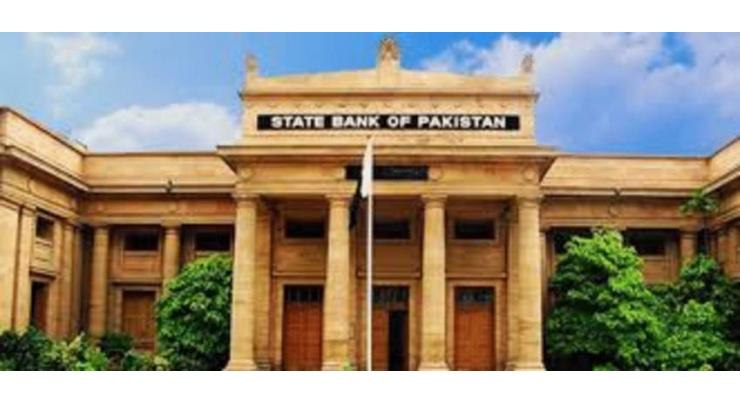
Real GDP Grew By 1.7% In H1-F24, Macroeconomic Conditions Improved: SBP
Sumaira FH Published May 14, 2024 | 10:38 PM

The State Bank of Pakistan (SBP) on Tuesday said that Pakistan's macroeconomic conditions improved and real GDP grew by 1.7% while inflationary pressures remained at elevated levels during the first half of fiscal year 2023-24
KARACHI, (UrduPoint / Pakistan Point News - 14th May, 2024) The State Bank of Pakistan (SBP) on Tuesday said that Pakistan's macroeconomic conditions improved and real GDP grew by 1.7% while inflationary pressures remained at elevated levels during the first half of fiscal year 2023-24.
The SBP, in its half yearly report, titled 'State of Pakistan’s Economy Report for H1-FY24' which contains analysis prepared on data out turns for the July-December FY24, stated that the real economic activities in the first half moderately recovered against the contraction last year and the trend was likely to continue in the second half of FY24 as well.
The real GDP, driven by the agriculture sector, grew by 1.7 percent during the period, the SBP noted and projected the real GDP growth for FY24 in the range of 2 to 3 percent in the backdrop of improvements in business confidence, high frequency demand indicators since November 2023, and prospects for a good wheat production during FY24.
In the first half, the recovery in agriculture sector also supported some of the agro-based industries while withdrawal of import prioritization measures improved availability of raw materials for the industry, the report mentioned.
Meanwhile, Stand-By Arrangement (SBA) with the IMF (International Monetary Fund) reduced stress on external account as its approval eased external borrowing constraints, leading to an increase in financial inflows during H1-FY24, the SBP observed.
The SBP also projected that current account deficit would remain in the range of 0.5 to 1.5 % of GDP for FY24, lower than earlier estimates amid slightly improved global outlook and domestic growth prospects to boost foreign exchange earnings from exports and remittances.
The current account deficit narrowed considerably, amid continued contractionary monetary and fiscal policies, better agriculture produce and ease in global commodity prices while on fiscal side, primary balance posted a higher surplus during H1-FY24 compared to H1-FY23 on account of strong growth in both tax and non-tax revenues that outpaced increase in non-interest expenditure.
The report further noted that lower scheduled external loan repayments compared to H1-FY23 and significant reduction in current account deficit, on account of decline in imports as well as upsurge in exports supported the build-up in the SBP's foreign exchange reserves.
The report stated that despite restrained domestic demand and decline in global commodity prices, “a combination of lingering structural issues, PKR depreciation compared to H1-FY23, increase in government spending, and supply shocks kept the National CPI (NCPI) inflation at elevated levels.
”
A number of factors including higher input costs, increase in indirect taxes, and implementation of upward revision in minimum wage announced in the FY24 budget, alongside the second-round effects of administered prices of food and energy items, were responsible for the persistence in the core inflation during H1-FY24, the half yearly report suggested.
The SBP foresaw downward trajectory in the NCPI inflation despite uncertainties persisting in both domestic economy and international commodity market and projected average NCPI inflation for FY24 in the range of 23.0 to 25 %, lower than 29.2 percent in FY23. The NCPI was expected to come down to 5 – 7 % range by September 2025, it added.
Pinpointing the structural bottlenecks grappling the economy, the report highlighted that limited savings, low investments in physical and human capital, weak productivity, stagnant exports, narrow tax base, and inefficiencies in public sector enterprises (PSEs) affected the economic recovery despite some improvement in macroeconomic indicators.
“Additionally, political uncertainty exacerbates the situation through inconsistency in economic policies, weak governance and public administration, hindering investment and thus economic development,” the report noted and underscored the need for policy reforms to ensure sustainable development over the medium to long-term.
Long-term trends in inflation and its determinants in Pakistan were analyzed in the report in a special chapter that also sheds light on policy and structural factors influencing inflation including monetary policy framework, fiscal and debt policy, trade openness, agricultural efficiency, productivity and demographic trends.
Reducing political and policy uncertainties and more fiscal consolidation could help bringing inflation down at a faster pace in the short run, the report suggested and also emphasized on addressing longstanding structural issues to achieve low and stable inflation over the medium term, without overburdening monetary policy and the consequent high economic costs.
The central bank cautioned that the macroeconomic outlook was susceptible to escalating geopolitical tensions, unfavourable weather conditions, adverse movements in global oil prices, and subsequent external account pressures while further adjustments in energy prices and fiscal consolidation - warranted for slowing the pace of debt accumulation - might also weigh on economic activities and inflation.
Related Topics
Recent Stories

NAB raids Malik Riaz's Bahria Town Rawalpindi office

‘Govt can boost revenues by 40 billion with optimized Tobacco Taxation’

Nawaz Sharif says they are of May 28, and not of May 9

Nawaz Sharif again elected unopposed as PML-N president

New complaint lodged against Imran Khan over alleged ‘hateful narrative’ aga ..

NAB law of 40-day physical remand be withdrawn, says Khawaja Saad

Experience Innovation at Its Best — vivo V30e 5G Now Available in Pakistan

Fiza Ali stuns with her rendition of “Kahani Suno” at London fashion show

PM takes notices of unannounced load-shedding in Pakistan

Spain officially recognizes Palestine today

Nation observing Youm-e-Takbeer today with national zeal

Currency Rate In Pakistan - Dollar, Euro, Pound, Riyal Rates On 28 May 2024
More Stories From Business
-
Comprehensive strategy being adopted to deal with economic challenges: Jam Kamal
6 hours ago -
Minister boosts trade ties with Tajikistan
6 hours ago -
Aleem Khan meets Tajikistan's Transport Minister
8 hours ago -
Iftikhar Ali Malik felicitates Nation on Youm-e-Takbeer
9 hours ago -
Cattle markets to be made functional 10 days before Eid: Commissioner
9 hours ago -
VCs committee demands continuation of financial support to universities
10 hours ago
-

‘Govt can boost revenues by 40 billion with optimized Tobacco Taxation’
11 hours ago -
Malik felicitates nation on Youm-e-Takbeer
12 hours ago -
Youm-e-Takbeer day of national pride, courage, determination: Ahsan Zafar
12 hours ago -
Chairman ICE promotes ‘Creative Economy’ concept to connect Pakistan with Indonesia's economy
12 hours ago -
Pakistan reviving Belt and Road Initiative projects: Ahsan Iqbal
13 hours ago -
Gold rates dip by Rs.500 per tola to Rs.240,300
13 hours ago






